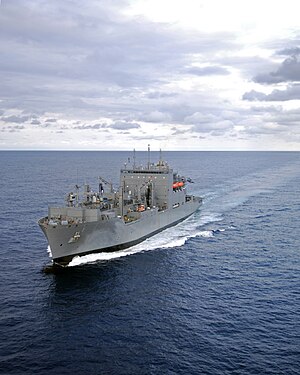
Back USNS Lewis and Clark (T-AKE-1) German USNS Lewis and Clark (T-AKE-1) Spanish یواساناس لوئیس و کلارک (تی-ایکیای-۱) Persian USNS Lewis and Clark (T-AKE-1) French USNS Lewis and Clark (T-AKE-1) Polish
 USNS Lewis and Clark in the Atlantic Ocean, December 2006
| |
| History | |
|---|---|
| Name | USNS Lewis and Clark |
| Namesake | Meriwether Lewis and William Clark |
| Ordered | 18 October 2001 |
| Builder | National Steel and Shipbuilding |
| Laid down | 23 March 2004 |
| Launched | 21 May 2005 |
| In service | 20 June 2006 |
| Identification |
|
| Status | in active service |
| General characteristics | |
| Class and type | Lewis and Clark-class cargo ship |
| Displacement | 41,000 tons (41,700 t) |
| Length | 689 ft (210 m) |
| Beam | 105.6 ft (32.2 m) |
| Draft | 29.9 ft (9.1 m) |
| Propulsion | Integrated propulsion and ship service electrical system, with generation at 6.6 kV by FM/MAN B&W diesel generators; one fixed pitch propeller; bow thruster |
| Speed | 20 knots (37 km/h) |
| Range |
|
| Capacity |
|
| Complement | 13 military, 123 civilian |
| Aircraft carried | two helicopters |
USNS Lewis and Clark (T-AKE-1) is an American dry cargo ship, the lead ship of her namesake class. It was the second ship of the United States Navy to be named for the explorers Meriwether Lewis and William Clark. The contract to build her was awarded to National Steel and Shipbuilding Company (NASSCO) of San Diego, California, on 18 October 2001 and her keel was laid down on 22 April 2004. She was launched on 21 May 2005, co-sponsored by Jane Lewis Sale Henley and Lisa Clark, descendants of the ship's namesakes. She was delivered to the Navy on 20 June 2006.